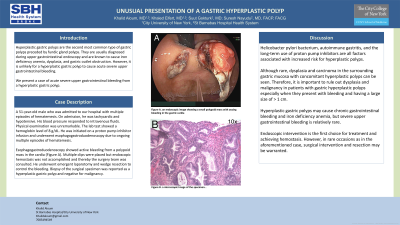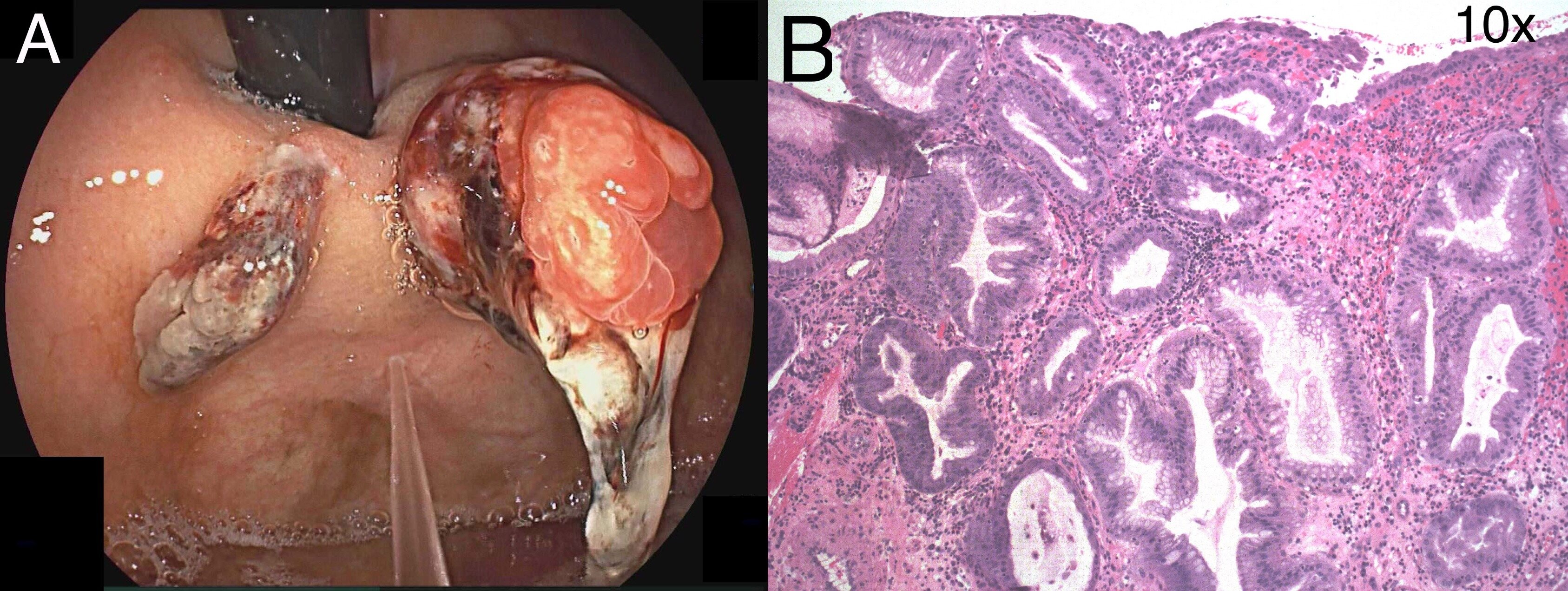Tuesday Poster Session
Category: Stomach
P4190 - Unusual Presentation of a Gastric Hyperplastic Polyp
Tuesday, October 24, 2023
10:30 AM - 4:00 PM PT
Location: Exhibit Hall

Has Audio

Khalid Aloum, MD
SBH Health System
Bronx, NY
Presenting Author(s)
Khalid Aloum, MD1, Khaled Elfert, MD1, Suut Gokturk, MD2, Suresh Nayudu, MD1
1SBH Health System, Bronx, NY; 2SBH, Cheshire, CT
Introduction: Hyperplastic gastric polyps are the second most common type of gastric polyps preceded by fundic gland polyps. They are usually diagnosed during upper gastrointestinal endoscopy and are known to cause iron deficiency anemia, dysplasia, and gastric outlet obstruction. However, it is unlikely for a hyperplastic gastric polyp to cause acute severe upper gastrointestinal bleeding.
We present a case of acute severe upper gastrointestinal bleeding from a hyperplastic gastric polyp.
Case Description/Methods: The patient was a 51-year-old male who was admitted to our hospital with multiple episodes of hematemesis. On admission, he was tachycardic and hypotensive. His blood pressure responded to intravenous fluids. Physical examination was unremarkable. The lab test showed a hemoglobin level of 8 g/dL. He was initiated on a proton pump inhibitor infusion and underwent esophagogastroduodenoscopy due to ongoing multiple episodes of hematemesis. esophagogastroduodenoscopy showed active bleeding from a polypoid mass in the cardia (Figure). Multiple clips were placed but endoscopic hemostasis was not accomplished and thereby the surgery team was consulted. He underwent emergent laparotomy and wedge resection to control the bleeding. Biopsy of the surgical specimen was reported as a hyperplastic gastric polyp and negative for malignancy.
Discussion: Helicobacter pylori bacterium, autoimmune gastritis, and the long-term use of proton pump inhibitors are all factors associated with increased risk for hyperplastic polyps.
Although rare, dysplasia and carcinoma in the surrounding gastric mucosa with concomitant hyperplastic polyps can be seen. Therefore, it is important to rule out dysplasia and malignancy in patients with gastric hyperplastic polyps especially when they present with bleeding and having a large size of > 1 cm.
Hyperplastic gastric polyps may cause chronic gastrointestinal bleeding and iron deficiency anemia, but severe upper gastrointestinal bleeding is relatively rare.
Endoscopic intervention is the first choice for treatment and achieving hemostasis. However, in rare occasions as in the aforementioned case, surgical intervention and resection may be warranted.

Disclosures:
Khalid Aloum, MD1, Khaled Elfert, MD1, Suut Gokturk, MD2, Suresh Nayudu, MD1. P4190 - Unusual Presentation of a Gastric Hyperplastic Polyp, ACG 2023 Annual Scientific Meeting Abstracts. Vancouver, BC, Canada: American College of Gastroenterology.
1SBH Health System, Bronx, NY; 2SBH, Cheshire, CT
Introduction: Hyperplastic gastric polyps are the second most common type of gastric polyps preceded by fundic gland polyps. They are usually diagnosed during upper gastrointestinal endoscopy and are known to cause iron deficiency anemia, dysplasia, and gastric outlet obstruction. However, it is unlikely for a hyperplastic gastric polyp to cause acute severe upper gastrointestinal bleeding.
We present a case of acute severe upper gastrointestinal bleeding from a hyperplastic gastric polyp.
Case Description/Methods: The patient was a 51-year-old male who was admitted to our hospital with multiple episodes of hematemesis. On admission, he was tachycardic and hypotensive. His blood pressure responded to intravenous fluids. Physical examination was unremarkable. The lab test showed a hemoglobin level of 8 g/dL. He was initiated on a proton pump inhibitor infusion and underwent esophagogastroduodenoscopy due to ongoing multiple episodes of hematemesis. esophagogastroduodenoscopy showed active bleeding from a polypoid mass in the cardia (Figure). Multiple clips were placed but endoscopic hemostasis was not accomplished and thereby the surgery team was consulted. He underwent emergent laparotomy and wedge resection to control the bleeding. Biopsy of the surgical specimen was reported as a hyperplastic gastric polyp and negative for malignancy.
Discussion: Helicobacter pylori bacterium, autoimmune gastritis, and the long-term use of proton pump inhibitors are all factors associated with increased risk for hyperplastic polyps.
Although rare, dysplasia and carcinoma in the surrounding gastric mucosa with concomitant hyperplastic polyps can be seen. Therefore, it is important to rule out dysplasia and malignancy in patients with gastric hyperplastic polyps especially when they present with bleeding and having a large size of > 1 cm.
Hyperplastic gastric polyps may cause chronic gastrointestinal bleeding and iron deficiency anemia, but severe upper gastrointestinal bleeding is relatively rare.
Endoscopic intervention is the first choice for treatment and achieving hemostasis. However, in rare occasions as in the aforementioned case, surgical intervention and resection may be warranted.

Figure: A, an endoscopic image showing a small polypoid mass with oozing bleeding in the gastric cardia. B, a microscopic Image of the specimen.
Disclosures:
Khalid Aloum indicated no relevant financial relationships.
Khaled Elfert indicated no relevant financial relationships.
Suut Gokturk indicated no relevant financial relationships.
Suresh Nayudu indicated no relevant financial relationships.
Khalid Aloum, MD1, Khaled Elfert, MD1, Suut Gokturk, MD2, Suresh Nayudu, MD1. P4190 - Unusual Presentation of a Gastric Hyperplastic Polyp, ACG 2023 Annual Scientific Meeting Abstracts. Vancouver, BC, Canada: American College of Gastroenterology.
